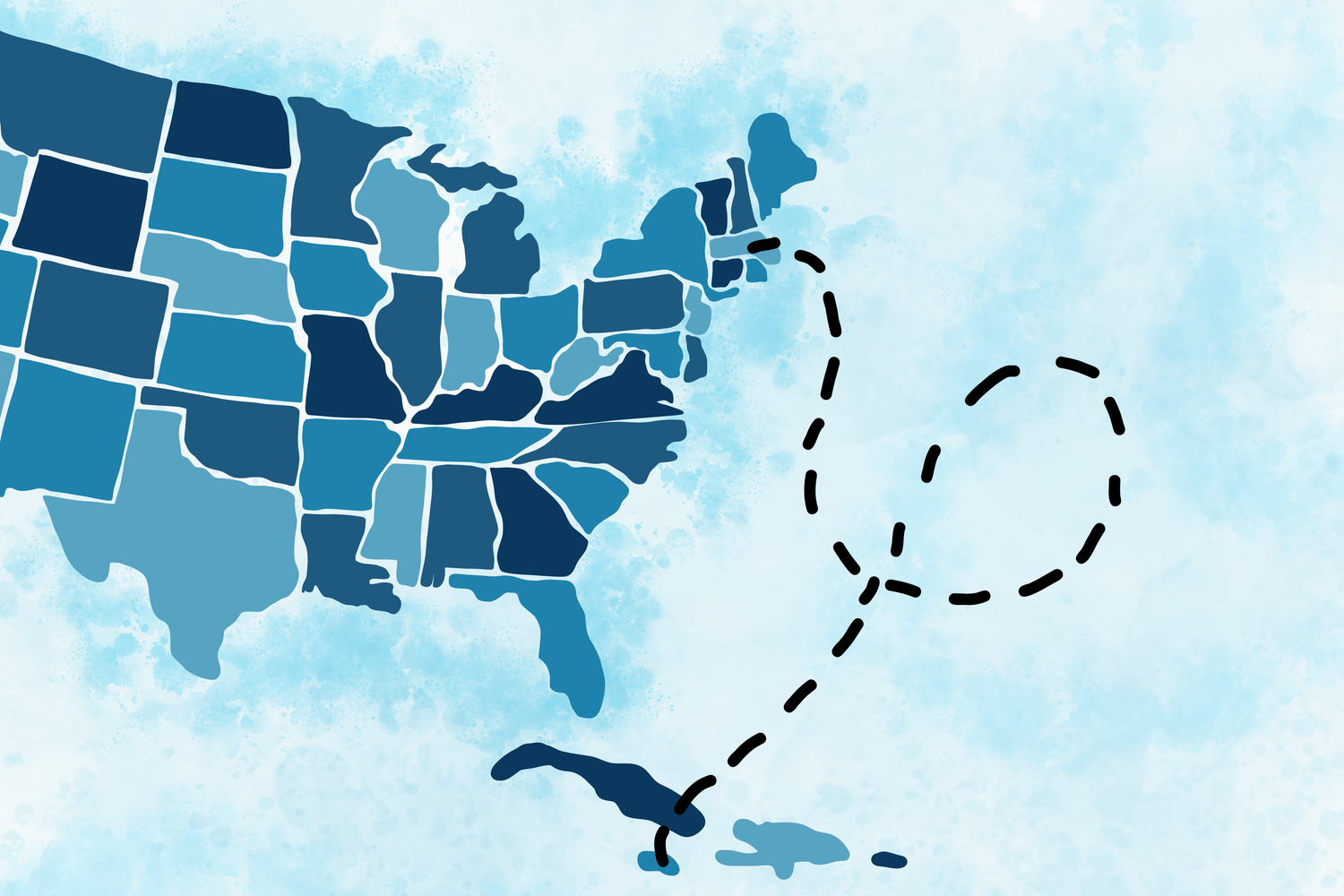Reminder: Your Spring Break Is in Someone Else's Home
More often than not, spring break asks us to find the closest thing we can to paradise on earth, park there, and bask in the sun because that is the peak manifestation of rest. Perhaps we yearn for ease and simplicity, perhaps for an escape. Either way, we travel with the expectation that this paradise will meet our needs and suit our whims, because that’s what we deserve after working so hard throughout the semester.
But how often do we consider what it takes for a place to become what we’ve conceived of as a paradise? What does it ask of the people, the landscape, the culture — or, rather, what it takes from them?
Seven years ago, my aunt Yvonne thought to celebrate her birthday at Puerto Seco, a beach along the northern coast of Jamaica, the island that raised her. It was just a short drive from family and two hours from Kingston, one of the only cities she’d learned to call home. But none of that — neither proximity, emotional tether, nor ancestral rools — would matter. She and her family were not welcome on that beach. It was for tourists only.
Perhaps you’re outraged and shocked by this — who wouldn’t be? We imagine some distant, daft American tourists who have no interest in education or cultural immersion; who are only willing to travel within the bounds of their all-inclusive resort; who grip unrelentingly to stereotypes about the local people. We imagine them walking on the beach, coated in SPF 5000, callously disregarding how their pleasure comes at the expense of the local people.
But we, too, are tourists. We, the spring breakers and the getaway-ers.
And it isn’t wrong to go somewhere warm, to bask in the sun, to be a tourist. In fact, tourism is critical to Caribbean economies. In Jamaica, for example, tourism is not merely valuable, it is fundamental to economic stability. According to The World Bank, the tourism industry supplies one-third of Jamaica’s jobs and sustains 30 percent of the country’s GDP.
“The general belief is that tourism brings income,” my aunt Yvonne says. “We have economic issues, we have employment issues, and for those reasons, it could be considered helpful to bring tourists to Kingston or to attract tourists to Kingston.”
But manipulating attraction is a dangerous game.
More often than not, Caribbean locals know what tourists expect, even before we ask. They know our typical American whims and exotic fantasies. They reproduce it for our enjoyment, regardless of its inauthenticity, as Professor Amber M. Henry, an anthropologist of Latin America and the Caribbean, explains to me.
“They know what tourists expect of them,” she says. “And they can quickly begin performing that back to us rather than existing authentically.”
What damage does that do to a place for a people and a culture to mold itself to suit the romantic caprices of its tourists — of us — especially when that place relies so heavily on the industry for economic stability?
According to Henry, it creates a disparity in investment — one that favors the whims of spring break travelers who spend one week there over the necessities of the people who live there when we’re gone.
In this way, tourism is a double-edged sword in the Caribbean. It provides jobs and income while molding the islands in accordance with tourist fantasies. Importantly, this double-edged sword was plunged deep into the archipelago centuries ago, at the hands of colonial exoticization and extractive paternalism.
When Christopher Columbus arrived in the Caribbean, he heralded the region for its abundant landscapes. Yet, in the same breath, he patronized the Indigenous populations, marveling at their willingness to trade gold and silver for broken plates.
From the outset, then, there was a strangely misaligned obsession with the rich landscape alongside a condescending disregard for the very stewards of that land. And in our own travel, we can perpetuate these same relationships — whether deliberately or not.
Perhaps it begins with a rigid separation we make between ourselves, our homes, the places we visit, and the people who live there.
“I’m going to go to a tourist destination and I’m going to talk to all the other people from the United States,” Henry says. “I’m relating to people who are familiar to me, but I’m not breaking that boundary of talking to someone who is a bit more ‘strange.’”
Sometimes we imagine traveling through this exoticized lens as though we’re going to a strange land with strange people. In fact, the richest travel experiences teach us about and bring us closer to ourselves. But that doesn’t always signify ease, and during spring break, we seek a well-deserved rest. So we search for bubbles, where our every expectation will be met and our requests will be granted because that is the function of these resorts. And the unfamiliar, or the strange, often don’t fit within this bubble.
As such, we’re prone to building walls, increasing security, and shutting local people out of their own land. Maybe we lock ourselves away because of some misguided conception of safety, or because we don’t want to be bothered by local vendors selling souvenirs. But the lines we draw in the sand are often to our own detriment if not to the detriment of residents, exiled from their homes to build more spaces for our spring break fantasies.
When spring break season descends upon us, how might we travel more consciously? How might we travel as though entering someone else’s home?
When we exoticize a place, we treat it differently than we would treat our own homes. Sometimes for better, sometimes for worse. We abide by different rules — if any at all — than we would abide by at home. And, oddly, we often grant ourselves an uncanny kind of newfound freedom.
If I were to go to your home, I wouldn’t expect your family to serve me. I wouldn’t block off your living room and call it my own. I wouldn’t enter your sacred spaces with a camera and a bikini. I wouldn’t treat your home as the mere backdrop to my desires.
But we think of the Caribbean this way. We relish these islands as strange decorations, the backgrounds to our itinerary. And at no time is this more clear than during spring break.
When we go on spring break, we’re so concerned with getting away — as though there are things we believe we can’t do in our own homes — that we can end up treating these islands as our personal playgrounds.
“It’s spring break, and people are just like, ‘let’s just vibe,’” says Felicha Nicolas ‘27, who went to Jamaica with thirteen of her friends this year for spring break.
And while wanting to liberate our worn psyches is completely reasonable, perhaps we would find more rejuvenation and refreshment with more conscious travel.
As much fun as she had, Nicolas returned to campus feeling unsatisfied. Limited largely to the bounds of her resort, Jamaica began to feel more like something out of a travel catalog than the culturally abundant home of some 2.85 million people.
“Nothing felt truly Jamaican outside of the fact that the workers were Jamaican,” she says.
Nicolas envisions traveling to Jamaica again, this time with the chance to experience the true richness of the island. “If I were to do it again, I would do something that allows me to be a little bit more immersed in what Jamaica has to offer. And I do think that is more than pretty beaches and resorts.”
In college, we have the great privilege of living alongside so many people who have traveled to every end of the earth. To Henry, that kind of knowledge sharing wields power in advancing more conscious tourist practices — especially in a place where spring breaking in the Caribbean is so popular.
“Maybe what we need are more tracks built around these conscious practices,” Henry says. “What if we had, even at Harvard, ‘Oh you want to go to Jamaica? Here are some great organizations, here are some community restaurants, here is this great eco-tourism spot.’ What if we were to circulate amongst ourselves some of those other tracks so we didn’t have to reinvent the wheel?”
Perhaps by now, you’re yawning at what appears to be the most obvious conclusion on the planet — sharing good spots amongst your friends and others. But, at the core of this proposition is a shift in our understanding of what makes a place, a site, a restaurant, a beach, an activity “good” when we travel. Is a place only good if your every whim will be catered to? If you won’t have to encounter many local people, perhaps especially those you’ve marked as dangerous? If you don’t have to respect the norms and rules that you would if you were going into someone’s home?
Might we desire places for different reasons? Choosing and recommending them based not on our minimizing fantasies, but based on whether we’re willing to engage with them holistically?
Jamaica is authentic oxtail and jerk chicken, fried plantains and bammy, ackee and saltfish. It is reggae, calypso, and dancehall. It is oral histories slipping from the lips of vendors and hiding in the steel drums of local musicians. It is elders on stoops passing wisdom and reprimand to whoever’s child happens by. It is homes filled with otherwise strangers, dominoes until deep in the night, and food cooked for 20 just in case someone walks by hungry. It is cultural pride, deep passion, and enduring gratitude in every season of life.
Jamaica is not merely beaches and lush landscapes, fitted to our conception of an idyllic paradise. So let us expand our conceptualization of a paradise, with a profound appreciation for the human and cultural stewards of that place. Let us travel in search of them, and in so doing perhaps return to our homes more refreshed and renewed than we imagined we could be.
—Magazine writer Anya Sesay can be reached at anya.sesay@thecrimson.com. Her column “The Islands That Shape Us” explores how our personal relationships with the Caribbean are entangled with its cultural erasure.



